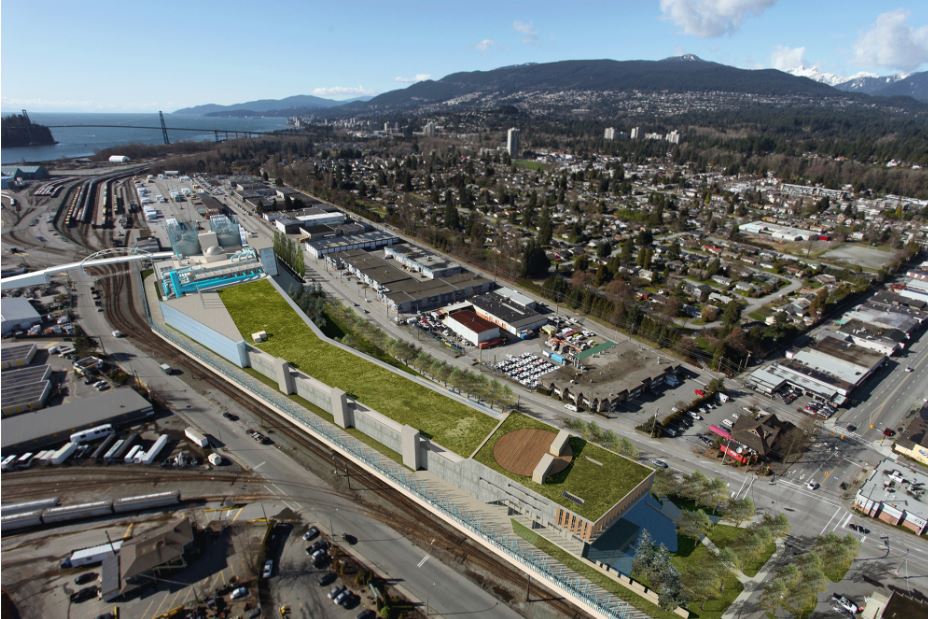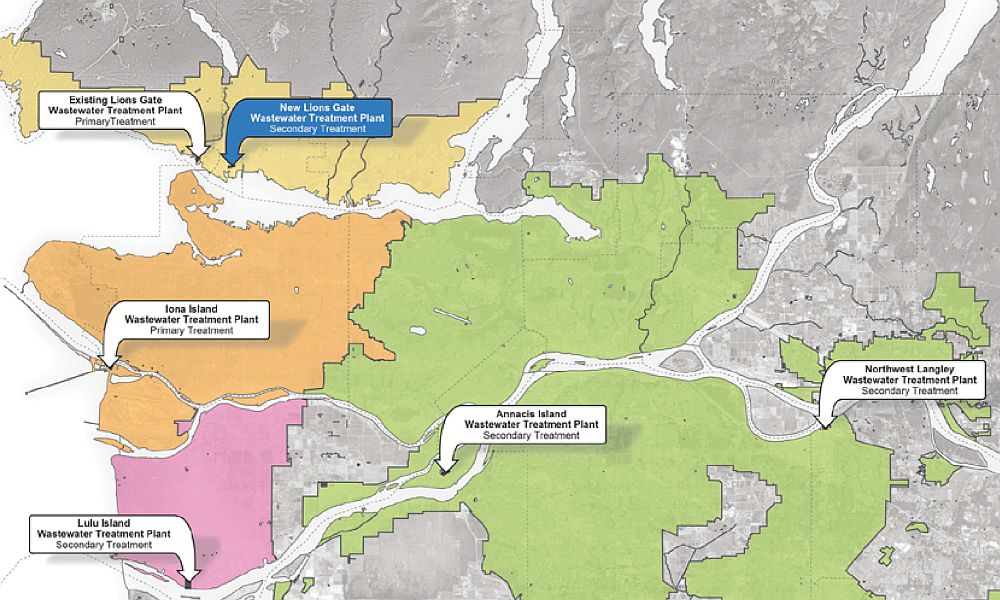LIONS GATE SEWAGE TREATMENT PLANT, METRO VANCOUVER: “Community advocates focussed political attention on the need to be visionary and dare to be bold in going beyond what is currently minimum standard of practice,” says Dr. Don Mavinic, a UBC engineering professor and world-renowned expert on wastewater treatment systems who has advocated for tertiary treatment
Note to Reader:
The September 2019 issue of the Asset Management BC Newsletter includes an article written by Kim Stephens, M.Eng., P.Eng, Executive Director, Partnership for Water Sustainability in BC. The article focus is on how elders are leading by example to bridge a demographic gap until Generations X, Y and Z take the inter-generational baton.
The context for the article is the current ‘climate emergency’. The article describes three examples of ‘elders in action’. All have relevance to asset management. They underscore why knowledge, experience and wisdom built-up over time are invaluable in first understanding what needs to be done, and then, how to get it done. When time is of the essence to change our practices, society no longer has the luxury of taking decades to re-invent the wheel.
The article connects four dots: the Doomsday Clock – the threat; Adapt to a Changing Climate – the challenge; Improve Where We Live – the vision; and, Asset Management for Sustainable Service Delivery: A BC Framework – an expectation.
The example of ‘elders in action’ featured below is the replacement Lions Gate Sewage Treatment, serving the North Shore region of Metro Vancouver.

Artist’s conception of the new Lions Gate facility
Sustainable Service Delivery in a Changing Climate:
A Moment of Reckoning!
Launched in 2015, Asset Management for Sustainable Service Delivery: A BC Framework sets a strategic direction for local government service delivery. It refocuses business processes on how constructed and natural assets are used to deliver services, and support outcomes that reduce life-cycle costs and address risks.
Development of the BC Framework was led by the Union of British Columbia Municipalities (UBCM) in partnership with Asset Management BC. When applying for infrastructure grants, communities must identify where they are within the asset management process using the Framework. Updated in 2019, the Framework is now complemented by a set of four companion Primers, released in September:
- Climate Change and Asset Management
- Integrating Natural Assets with Asset Management
- The Role of Operations & Maintenance in Asset Management
- Land Use Planning and Asset Management
“ Local governments are implementers. This means they can be change leaders. They can integrate climate adaptation into the activities and actions of engineered and natural asset management – or flipping it around, integrate asset management into the activities and actions of climate adaptation. Local government partnerships with the stewardship sector have the potential to be transformational to ‘improve where we live’,” wrote Kim Stephens.
Local governments are implementers. This means they can be change leaders. They can integrate climate adaptation into the activities and actions of engineered and natural asset management – or flipping it around, integrate asset management into the activities and actions of climate adaptation. Local government partnerships with the stewardship sector have the potential to be transformational to ‘improve where we live’,” wrote Kim Stephens.
A challenge to Generations X, Y and Z
– accept the inter-generational baton offered by those who can help you make a difference to improve where you live
 “Greenland’s glaciers are melting; the Amazon forest is on fire. At a moment in history when the phrase ‘climate emergency’ is top of mind for many, and given that there is no easy or quick fix, the article reminds us that history repeats itself. Or, as the French writer Jean-Baptiste Alphonse Karr wrote in 1848, ‘the more things change, the more they are the same’,” continued Kim Stephens. Karr (1808-1890) was a French critic, journalist and novelist.
“Greenland’s glaciers are melting; the Amazon forest is on fire. At a moment in history when the phrase ‘climate emergency’ is top of mind for many, and given that there is no easy or quick fix, the article reminds us that history repeats itself. Or, as the French writer Jean-Baptiste Alphonse Karr wrote in 1848, ‘the more things change, the more they are the same’,” continued Kim Stephens. Karr (1808-1890) was a French critic, journalist and novelist.
“A half-century ago, society was galvanized by a daunting challenge. Learn from elders how to do it again. The Lions Gate Treatment Plant example of ‘elders in action’ underscore why knowledge, experience and wisdom built-up over time are invaluable in first understanding what needs to be done, and then, how to get it done. When time is of the essence to change our practices, society no longer has the luxury of taking decades to re-invent the wheel.
“So, what can communities do from a sustainable service delivery perspective – and how quickly can the process be set in motion – to successfully tackle the challenges for the built environment caused by the accelerating rate of climate change, and thus improve where we live?”
To Learn More:
Download Sustainable Service Delivery in a Changing Climate – A Moment of Reckoning! to read the article by Kim Stephens.

Lions Gate Treatment Plant, Metro Vancouver
Motivated by a shared vision that “the future is here, NOW” for restoration of the aquatic environment in Burrard Inlet, three engineers with distinguished careers have been passionate and relentless in collaborating as an interdisciplinary team to convince the Metro Vancouver Regional District to re-think the treatment components for the new Lions Gate Treatment Plant.
Glen Parker (industry) had worked around the world on petroleum industry projects before retiring to become an activist streamkeeper. Dr. Don Mavinic (academia) is an internationally recognized expert in sewage treatment. Dr. Ken Ashley (government) is also internationally recognized. His expertise is in aquatic ecology.
The efforts of this trio have been complemented by streamkeeper Shaun Hollingsworth, President of the Seymour Salmonid Society. “Thanks to the influence of Glen Parker, Shaun Hollingsworth and Ken Ashley, I now include ‘fish’ as a resource, in my holistic approach to modern liquid waste management,” states Don Mavinic.

The Future is Here, Now!
The decision to build a treatment plant has life-cycle implications that are multi-generational in terms of environmental outcomes – for example, the existing Lions Gate facility has been in service for 58 years. Drawing on their unique combination of expertise, these elders focussed political attention on the need to be visionary and dare to be bold in going beyond what is currently minimum standard of practice.
In 2013, new federal regulations spelled out secondary treatment as the minimum standard required for the new Lions Gate facility. Not good enough, said the three elders. “Recent studies have shown harmful chemicals and pharmaceuticals present in local waters and in juvenile salmon. How stupid would it be to build a $778 million plant and have it out of date before it even opened,” questions Ken Ashley.
“A months long construction shutdown opened the door to the re-think,” says Glen Parker. “The Federal Government has embraced the vision and is signalling that they will share the cost of adding tertiary treatment. Cleaner water is good for fish and whales!”
“If tertiary treatment is used, the pipes into the ocean used to dilute the sewage could be eliminated; and the cleaned water could be used to re-establish estuary habitat. It is not right that we take water from our streams, pollute it, and bypass the estuaries so we can use the ocean to dilute the pollutants.
“By making presentations to community groups and business leaders, we have experienced how public and political sentiments can be shifted. Without political support, nothing happens. Many elected representatives seem to operate on the model that anything that gets them votes is by definition ‘right’. This may work for short term issues but longer term issues need a different model, or efforts of ‘elders’ to make the wind blow in the ‘right’ direction.”
“Now, there is no looking back…. ’elders power, combining mind and action’,” concludes Don Mavinic.
To Learn More:
Read the article published in the North Shore News: Activists hopeful advanced sewage treatment still an option for North Shore
Environmental Advocates Applaud $29 Million Rethink by Metro Vancouver Politicians
Metro Vancouver politicians voted at a closed-door meeting in July 2019 to upgrade the design of the plant to a tertiary level of treatment at an additional cost of $29 million. That decision was made public in September 2019.
“We had hoped for both a more advanced level of tertiary treatment and elimination of an ocean outfall to Burrard Inlet in favour of restoration of a foreshore estuary,” said Glen Parker.
“We would also like the plant eventually operate at a higher level of tertiary treatment to significantly reduce pharmaceuticals in wastewater effluent. If you’re going to do it properly that is the next step in the process,” added Don Mavinic. “Still, the glass is half full. The process does show that public pressure can really make a difference.”
To Learn More:
To read the complete story published by the North Shore News about the rethink by Metro Vancouver politicians, download Metro approves tertiary treatment for North Vancouver sewage plant

Throughout the design process the landscape architects played an integral role in defining the concepts for the plant, identifying opportunities for the facility and site, and exploring how the plant can be integrated with the community. Some key strategies incorporate into the final design as a result of participation by the landscape architect include: development of a place-specific, civic expression of the facility; establishment of a public face that relates to the existing neighbourhood structure; creation of on-site outdoor spaces for the community; and integration of on-site rainwater management strategies.


